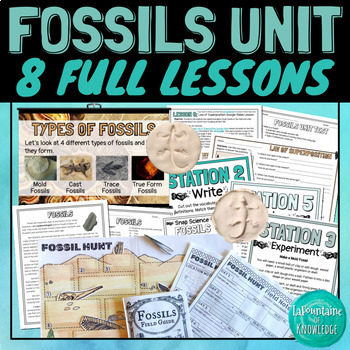Fossils and Paleontology Unit Bundle of 8 Science Lessons
- Zip
- Easel Assessment
Products in this Bundle (7)
showing 1-5 of 7 products
Description
This fossils unit bundle includes 8 one hour lesson plans with all of the resources needed to implement them in your science classroom. The unit explains what fossils are and how they form, 4 different types of fossils (mold, cast, trace, and true form), the law of superposition (relative dating), and how and why paleontologists study fossils to learn about our world.
This bundle includes:
- Types of Fossils Google Slides lesson
- notes page (empty and pre-filled)
- worksheet to demonstrate comprehension after the Google Slides lesson (plus and answer key)
- "Fossils" reading passage with 10 multiple choice questions, an answer key, and a read aloud video with visuals you can use as a modification or for review
- 5 Fossils science stations including a stations booklet, station directions, and all other printables needed to set up the stations (plus a scoring rubric)
- Make a Cast Fossil science experiment
- Law of Superposition (Relative Dating) Google Slides, notes page and worksheet
- Fossil Hunt paleontologist simulation activity
- a 20 question end of unit assessment and answer key
The resources included in this unit bundle are available for sale individually. However, buying this bundle saves you 30%.
Please follow my store here for more great resources!
You can also find me on Facebook, Instagram, and lafountaineofknowledge.com where you'll discover ideas, inspiration, and plenty of freebies! Or join my email list to get my monthly newsletter with exclusive FREE resources you can't get anywhere else!
Want free money to spend on Teachers Pay Teachers? Rate this product to earn some TpT credit! Leaving feedback helps us both out and takes less than a minute! Your support makes it possible for me to continue making and sharing great resources! Thank you!





